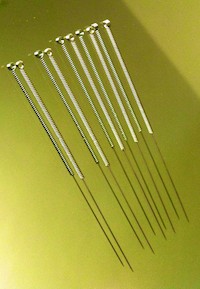Acupuncture MRI imaging pioneer Dr. Joie Pierce Jones has died at the age of 72.  His revolutionary work led to the first scientific evidence of the existence of acupuncture points and their effects on the brain. Dr. Jones had a distinguished career in the medical applications of ultrasound technology and developed several new ultrasonic imaging techniques for the medical field. Dr. Jones also served as a faculty member of Case Western University (Cleveland, Ohio) and at the University of California, Irvine as a professor of radiological sciences.
His revolutionary work led to the first scientific evidence of the existence of acupuncture points and their effects on the brain. Dr. Jones had a distinguished career in the medical applications of ultrasound technology and developed several new ultrasonic imaging techniques for the medical field. Dr. Jones also served as a faculty member of Case Western University (Cleveland, Ohio) and at the University of California, Irvine as a professor of radiological sciences.
Dr. Jones’ impact on acupuncture research is nothing short of revolutionary. Together with Dr. Young Bae, their team was able to use MRI technology to map the specific effects of acupuncture on the brain. Dr. Bae is both an acupuncturist and holds a Ph.D. in high energy physics from the University of California, Berkley. Dr. Jones received his Ph.D. studying underwater acoustics at Brown University.
3D Imaging
The work of Jones and Bae using a combination of fMRI and ultrasound technology led to ground breaking discoveries in a variety of fields including acupuncture. Dr. Jones developed a 50 MHz ultrasonic technique to digitize reflected signals from acupuncture points stimulated with an ultrasonic pulse. The results produced a 3D image of the size, shape and depth of the acupuncture points. Further, the effects of stimulating one acupuncture point on the changes in the size, shape and depth of other acupuncture points on the same acupuncture meridian were also measurable. Dr. Jones developed the ability to watch this process in realtime.
The work of Jones and Bae combined ultrasound with fMRI investigations into the effects of acupuncture on the brain. It took 101 computers operating simultaneously to measure the results from an acupuncture point stimulated during the acquisition of the data. Each 3 second snapshot of acupuncture point stimulation produces a half terabyte of data. The results were somewhat surprising.
The findings are as follows. Quantitative ultrasound methods can image acupuncture points. Ultrasound at higher intensities can stimulate acupuncture points in much the same way as do acupuncture needles. In some cases, the stimulation levels were indistinguishable between acupuncture needling and ultrasound stimulation when measuring cortical responses. The acupuncture points actually twist around needles as they are stimulated. Acupuncture points can change in size, shape and location over short periods of time. Dr. Jones and his colleagues presented this material to the Annual Meeting of SSE in La Jolla, California in 2001 and then at the University of Virginia in 2002. Next, the results were published in Medical Acupuncture in 2004 and then in Acoustical Imaging in 2004 as well.
Dr. Jones and Dr. Bae delineated three pathways by which acupuncture sends signals to the brain using fMRI measurements. The very fast signal is less than or equal to 0.8ms, another signal travels along nerve pathways and arrives at the brain in 180 - 200ms and a very slow signal arrives at the brain in 15 - 25 seconds as measured from stimulation of acupuncture point UB67 on the foot. The very slow signal travels at a rate of 5 - 10 cm per second. The stimulation process communicates to other acupuncture points along the meridian at this rate. Some subjects could physically sense this process, sometimes referred to as the stimulation of Qi.
Discovery: Speed
The initial time between ultrasonic stimulation of an acupuncture point and brain activity is less than or equal to 0.8ms. Dr. Jones noted that this is two orders of magnitude faster than any other known process. If a non-acupuncture point is stimulated, this rapid response is not observed. If one stimulates a true acupuncture point, the speed is less than or equal to 0.8ms, which is incredibly fast and unequalled. Only acupuncture points carry information at this speed.
Specificity
Dr. Jones and Dr. Bae measured acupuncture point specificity. The first studies were conducted from 1996 to 1998. The team compared acupuncture point stimulation at UB67 with flashes of light to the eyes. Subjects first received acupuncture point stimulation to UB67 while blindfolded. The fMRI measurements showed that the visual cortices of the brain lit up from the acupuncture point stimulation. Next, subjects were not blindfolded, did not receive point stimulation but instead were exposed to flashes of light to the eyes. The same visual cortex response occurred in both cases. Stimulation of acupuncture point UB67 and light stimulation produced the same effects on the brain. Stimulation of non-acupuncture points did not produce this effect. UB67 has been indicated for the treatment of eye disorders within the Traditional Chinese Medicine (TCM) system for over 1,000 years. The work of Dr. Jones brought this traditional indication into the realm of the modern scientific paradigm.
Shift in Thinking
Five nobel prize winners wrote supportive reviews on the quality of the research. Despite this, Science refused to review the research and Nature refused to publish it although the Tokyo editor noted that the research was fascinating. Some of the pushback on the work of Dr. Jones occurs because it fundamentally shifts the scientific paradigm. The conventional community does not readily accept science that is ultimately ahead of its time. We can only hope that other brave scientists will continue this type of groundbreaking work made possible by Dr. Jones.

